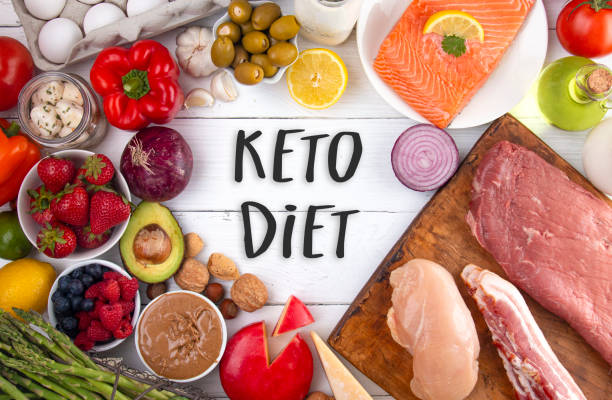Keto Diet for Beginners: Your Ultimate Guide to Starting Keto the Right Way

keto diet has gained massive popularity in the U.S.—and for good reason. With its potential for weight loss, better mental clarity, and blood sugar control, keto offers benefits beyond the plate. But if you’re just starting out, the idea of drastically cutting carbs and loading up on fats might feel overwhelming.
This guide breaks it all down in plain, beginner-friendly language—no scientific jargon, no overpromising. Just a clear path to understanding and starting keto the right way.
What Is the Keto Diet?
The ketogenic (keto) diet is a low-carb, high-fat eating plan that trains your body to burn fat for fuel instead of carbohydrates. This metabolic state is called ketosis.
Typically, your body relies on glucose (from carbs) for energy. But when you limit carb intake (usually to 20–50 grams per day), your liver converts fat into ketones, which become your body’s main fuel source.
Benefits of the Keto Diet
Many Americans turn to keto for weight loss—but the benefits don’t stop there:
Weight loss: Keto naturally reduces hunger, and burning fat for fuel can lead to rapid fat loss.
Improved blood sugar control: Helpful for people with type 2 diabetes or insulin resistance.
Increased mental focus: Ketones are a more stable fuel source for the brain.
Better energy levels: No more crashes from carb-heavy meals.
Reduced inflammation: Some people notice less joint pain and bloating.
Keto Macronutrients Explained
On keto, you focus on three macros:
Fats: 70–75% of daily calories
Proteins: 20–25%
Carbohydrates: 5–10% (usually 20–50g per day)
A typical 2,000-calorie keto day in the U.S. might look like:
155g fat
100g protein
25g net carbs
Net carbs = Total carbs – fiber – sugar alcohols (like erythritol)
What Foods Can You Eat on Keto?
✅ Keto-Approved Foods
Meat and poultry: Beef, pork, chicken, turkey
Seafood: Salmon, mackerel, sardines (high in omega-3s)
Eggs: Whole eggs are perfect for keto
Healthy fats: Avocados, olive oil, coconut oil, butter
Low-carb vegetables: Spinach, kale, broccoli, cauliflower, zucchini
Cheese and full-fat dairy: Cheddar, cream cheese, heavy cream
Nuts and seeds: Almonds, walnuts, chia seeds, flaxseeds
Berries (in moderation): Strawberries, blackberries, raspberries
❌ Foods to Avoid
Bread, pasta, rice, tortillas
Potatoes, sweet potatoes, corn
Most fruits (except a few berries)
Sugar, honey, maple syrup
Soda, fruit juice, and sports drinks
Beer, sweet wines, and high-carb alcohol
How to Start Keto : Step-by-Step
1. Set a Goal
Is it weight loss? Blood sugar control? Mental clarity? Be clear so you can track results.
2. Clean Out Your Pantry
Get rid of high-carb temptations: cereals, chips, crackers, cookies, soda. Out of sight, out of mouth.
3. Stock Up on Keto Staples
Make your first grocery run easier with this basic list:
Eggs
Bacon
Ground beef
Chicken thighs
Avocados
Spinach
Cheese (cheddar, mozzarella)
Butter and olive oil
Heavy cream
Almond flour
Coconut flour
Erythritol or monk fruit sweetener
4. Download a Carb Tracker App
Try Carb Manager, MyFitnessPal, or Cronometer. Tracking helps you stay in ketosis, especially during the first few weeks.
5. Prepare for the “Keto Flu”
Some new keto dieters experience fatigue, headaches, and brain fog during the first week. It’s temporary and due to electrolyte imbalance. Stay hydrated and increase:
Salt
Magnesium (almonds, spinach)
Potassium (avocados, leafy greens)
What’s a Sample Keto Meal Plan?
Here’s a 1-day keto-friendly meal plan for beginners:
Breakfast
Keto scramble: 3 eggs, spinach, mushrooms, cheddar cheese, and avocado slices.
Lunch
Grilled chicken Caesar salad (skip croutons, add extra olive oil and parmesan)
Snack
Hard-boiled eggs or string cheese
Dinner
Salmon with garlic butter and roasted broccoli
Dessert
Keto chocolate mousse (made with heavy cream, cocoa powder, and erythritol)
Dining Out on Keto in the U.S.
Yes, you can still enjoy dining out without wrecking your progress. Just keep these tips in mind:
Go bunless: Order burgers wrapped in lettuce.
Skip the fries: Ask for a side salad or steamed veggies.
Customize your order: U.S. restaurants are used to special requests—don’t be shy.
Watch sauces and dressings: Ask for them on the side to avoid hidden sugars.
Keto on a Budget
Keto doesn’t have to be expensive—even in the U.S. Here’s how to keep costs down:
Buy in bulk at Costco or Sam’s Club
Choose cheaper cuts of meat like ground beef or chicken thighs
Shop seasonal produce and frozen veggies
Use eggs as a protein base—cheap and versatile
Cook at home more often to avoid overpriced restaurant options
Common Mistakes to Avoid
Not eating enough fat: You need it to stay full and in ketosis.
Overeating protein: Extra protein can be turned into glucose.
Skipping electrolytes: Drink broth, add salt, and take supplements.
Obsessing over the scale: Focus on how your clothes fit and energy levels.
Is Keto Safe for Everyone?
The keto diet is safe for most people, but not everyone. You should talk to your doctor if you have:
Type 1 diabetes
Kidney or liver conditions
History of eating disorders
Are pregnant or breastfeeding
Always make major dietary changes under professional guidance, especially if you’re on medication.
Long-Term Tips for Keto Success
Mix it up: Rotate recipes to avoid boredom.
Don’t fear fat: It’s your fuel on keto.
Find a keto buddy: Support makes a big difference.
Keep learning: Read labels, research ingredients, and follow U.S.-based keto communities on Reddit, Facebook, or YouTube.
Starting the keto diet in the U.S. doesn’t have to be complicated. With a little planning, a lot of bacon, and a willingness to learn, you can totally transform your health. Focus on whole, nutrient-dense foods, keep carbs low, and listen to your body. The results—fat loss, energy boosts, and mental clarity—will be worth it.
Want more beginner-friendly keto tips, recipes, and meal plans? Bookmark our site and join our keto newsletter today!

krista Bendova
krista Bendova is a passionate health and wellness writer who shares her expertise to inspire readers to prioritize self-care. With a background in holistic nutrition and alternative therapies, she provides practical advice, mindful living tips, and natural remedies. Isabella’s genuine interest in well-being extends beyond her writing, as she enjoys practicing yoga, exploring organic farming, and experimenting with herbal remedies in her own garden.












